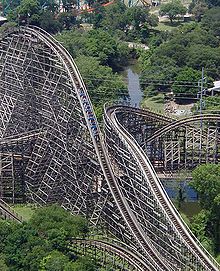Kinetic energy From Wikipedia, the free encyclopedia
The
kinetic energy of an object is the energy which it possesses due to its motion.
[1] It is defined as the work needed to accelerate a body of a given mass from rest to its stated velocity. Having gained this energy during its acceleration,
the body maintains this kinetic energy unless its speed changes. The
same amount of work is done by the body in decelerating from its current
speed to a state of rest.
The speed, and thus the kinetic energy of a single object is
frame-dependent (relative): it can take any non-negative value, by
choosing a suitable inertial frame of reference.
For example, a bullet passing an observer has kinetic energy in the
reference frame of this observer, but the same bullet is stationary, and
so has zero kinetic energy, from the point of view of an observer
moving with the same velocity as the bullet.
[2] By contrast, the total kinetic energy of a system of objects cannot be
reduced to zero by a suitable choice of the inertial reference frame,
unless all the objects have the same velocity. In any other case the
total kinetic energy has a non-zero minimum, as no inertial reference
frame can be chosen in which all the objects are stationary. This
minimum kinetic energy contributes to the system's invariant mass, which is independent of the reference frame.


The cars of a roller coaster
reach their maximum kinetic energy when at the bottom of their path.
When they start rising, the kinetic energy begins to be converted to
gravitational potential energy. The sum of kinetic and potential energy in the system remains constant, ignoring losses to friction.













 to the forum. I haven't subscribed to your channel yet, but will do. Keep those updates coming, Ivo and the guys on here are all about crossbows and will help out for sho!
to the forum. I haven't subscribed to your channel yet, but will do. Keep those updates coming, Ivo and the guys on here are all about crossbows and will help out for sho! 






 Private messages
Private messages